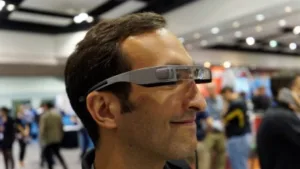Atheer has been supplying smartglasses to be used with its software, but it is in the process of moving to become a software supplier, rather than hardware, so is also happy to work with headsets and smartglasses from ODG and others.
Avegant is interested in the consumer space and has a ‘personal cinema’ system based on a headphone form factor. The display area is in the ‘band’ of the headset, which is swivelled down to be in front of the eyes. The imagers are 1280 x 720 DLP units and the company claims a 40 degree FOV. The batteries in the system are said to support four hours of use and head tracking is integrated. Your reporter tried the system, but found the images of good quality, but small and the weight of the headset on the nose was uncomfortable very quickly.
Benchmark Electronics has worked with MVS (Making Virtual Solid of San Diego) to develop a HUD concept based on an LED-based DLP projection system. The performance was not exceptional and the unit looked quite large for this kind of application, but the company is very flexible to work with potential customers on custom designs and modifications.
Epson was showing its new Moverio glasses which are dramatically better than previous versions, in our opinion. The company told us that it will continue to offer the 2000 system when the BT-300 system starts to ship, as the 2000 system will continue be a better option for some industrial applications. At AWE, the main focus was on work being done with partners.
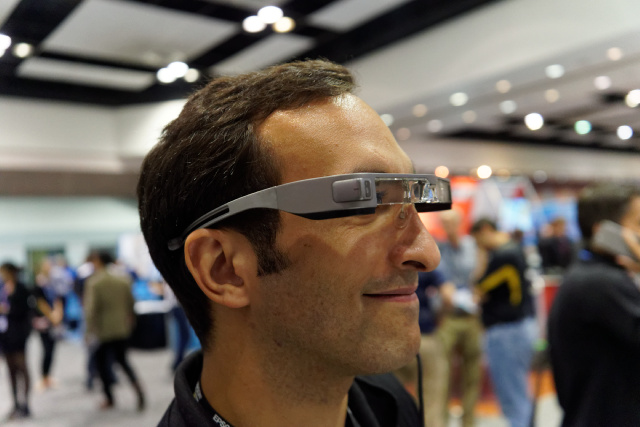 Epson’s new Moverio – Image:Meko
Epson’s new Moverio – Image:Meko
The HDBaseT group and Valens, were at the show to highlight the advantages that HDBaseT has in being able to support audio, video and networking as well as power being supplied to the headset in VR and A/R applications. At the moment, as we found at the event, some of the headsets need a bundle of cables to support everything needed and HDBaseT can deal with all of them with a single cable. (of course, the USB group would say that USB Type C could also do this, although longer cables might be an issue). The cable was particularly thin and light.
On the corner of its booth, Intel had a demo from ‘Torch‘ which was showing a real sandbox game. The idea is that players can rearrange the sand, into hills and valleys and when that is done and you are ready to play, Intel’s RealSense system detects the shape of the sand and a custom image is projected on the surface. The hills in the sand are modelled in the game which involves firing guns over the hills. An impressive application in arcade gaming, it seemed to us.
 Torch uses Realsense to projection map this sandbox. Image:Meko
Torch uses Realsense to projection map this sandbox. Image:Meko
Leap Motion was demonstrating its gesture recognition system.
Lumus has been a supplier of diffraction-grating based optical components and engines for smartglasses for a long time – we started reporting on the company at SID 2005. This reporter has always been impressed with its technology and at the show the company was demonstrating its latest technology, which looked very good. The company wants to remain a component and ip supplier and its optical modules were being used by a number of suppliers at the event, including Atheer. A number of interesting applications were being shown including a simple patttern recognition system that could recognise large patterns on objects – such as boxes to be delivered.
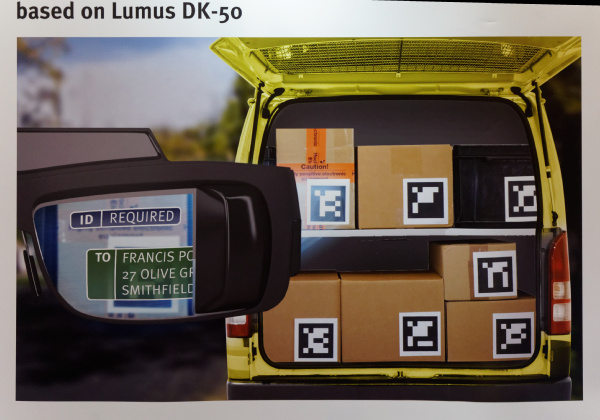 Application for packaging delivery. Image:Meko
Application for packaging delivery. Image:Meko
Osterhout Design Group was at the show and was a major sponsor. It started its demo to us with the currently shipping headset that it showed at CES and a prototype setup of the next version that will be coming along. The prototype was set up in a fixed position (which caused problems for at least one attendee that I spoke to who was very short and had to stand on a box!). The optics were basically the same as seen at the SID Investors Conference last week and are very impressive (ODG Sneaks a Preview of its New Glasses). There has been some speculation that the imagers being used in the new headset are based on OLEDs from eMagin, which has said that it has done a deal with an un-named company for headset use.
The company also announced a collaboration with Otoy, which is a software company that provides GPU- and cloud-based software for graphics, especially in 3D. Among Otoy’s products is OctaneRender, which is claimed to be the world’s first and fastest GPU-accelerated, unbiased, physically correct renderer.
 Otoy has sophisticated renderers – click for higher resolution
Otoy has sophisticated renderers – click for higher resolution
Laster Technologies is based in Les Ulis, south west of Paris in France and has developed a monocular “Wav3” A/R system that includes a full Android implementation. The unit uses a 800 x 480 microdisplay with up to 4,200 cd/m² of brightness, giving a 21 degree field of view and with a >12mm eye box. The system uses what looks like a beam-splitter optic to offer an image superimposed on the world view. The company has a number of options including an 8MP camera with a 50 deg FOV, bone conduction headphones, an embedded mic and a swappable battery. Life time is quoted at ‘up to’ 5 hours.
Phonevers is a Chinese supplier of wearable systems that include a full Android system, based on an Arm Cortex A15 with 4GB of RAM and 64GB of flash storage. The headset has a touchpad on the side and uses 1280 x 720 resolution imagers, although the system can also be used in a 3D mode, with lower resolution.
We weren’t looking at content creation, particularly, at the show, but QueenB Robotics had the Exo360, which is a drone with integrated 360 degree video capture, and was getting a lot of interest in its product. It has four integrated cameras, and the pro version has UltraHD (30fps) support, while the regular version has FullHD support. The system includes ‘on-board’ video stitching. The product is being offered on Indiegogo at $1,099, compared to an MSRP after the promotion, of $1,649.
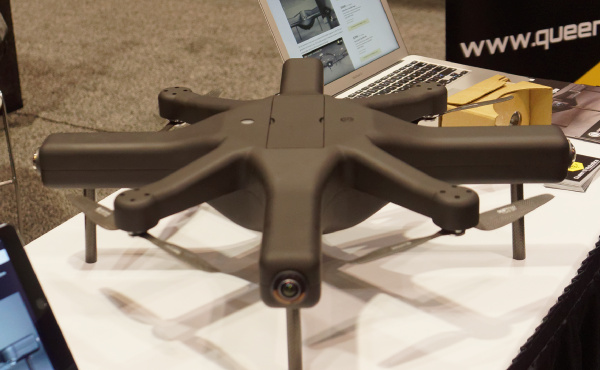 The Exo360 drone. Image:Meko
The Exo360 drone. Image:Meko
We have reported on RaonTech several times in recent months. The company was showing its latest LCoS devices and also a range of optical solutions for A/R applications. It is working with a number of OEMs and ODMs.
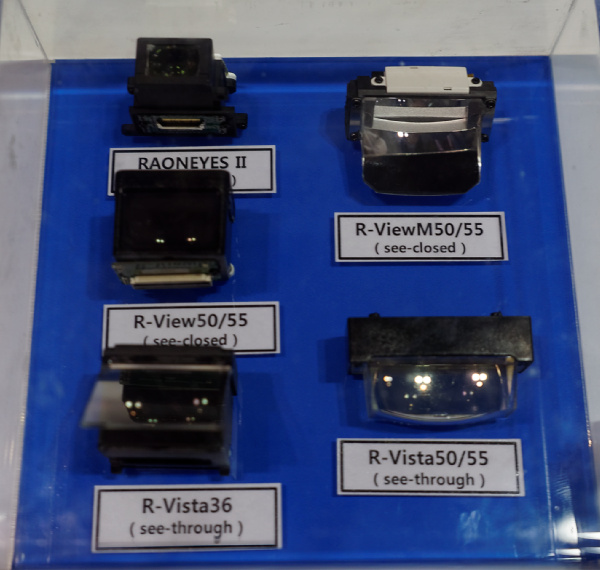 Raontech optics – Image:Meko
Raontech optics – Image:Meko
Recon Instruments, which has been acquired by Intel, was showing its Jet system, which is a headset for professional or sports applications. It has a small imager that blocks the view of the world behind it and is limited to sitting at the bottom of the field of view, although there is some adjustment available. The battery is housed in one of the glasses arms, while the processor is on the other side.
SeeBright had a low cost smartphone holder that could be used for A/R without headmounting – think ‘Cardboard for AR’ (rather than VR). The unit, called the Ripple, costs $39.99. We didn’t find it very comfortable, although it worked well enough (for the price!). The company is also developing a more upmarket headset.
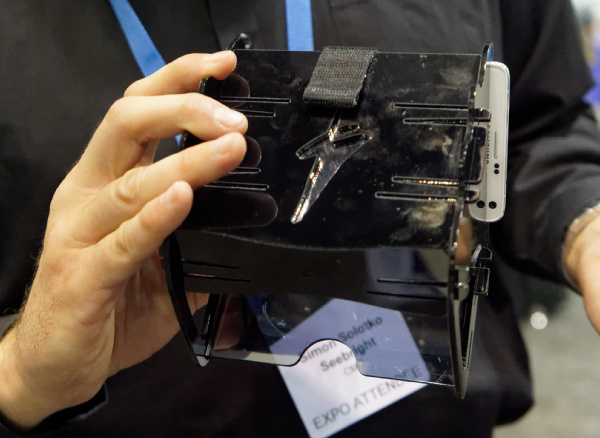 Seebright’s $40 Ripple – Image:Meko
Seebright’s $40 Ripple – Image:Meko
Six15 is a reseller of VR and AR systems including Vuzix headsets. At the show, the company was showing an in-house developed dual eye A/R system.
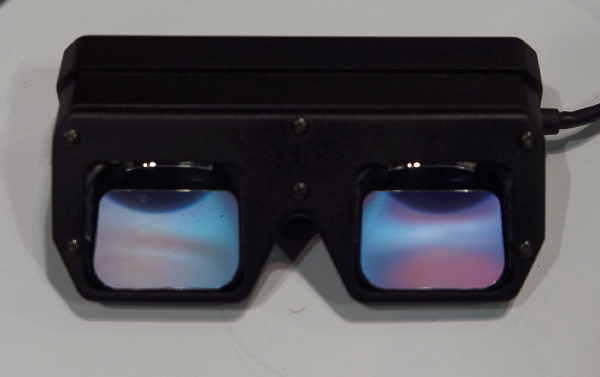 Six15’s glasse. Image:Meko
Six15’s glasse. Image:Meko
SMI of Germany was showing its latest gaze recognition glasses – the technology can also be included in headsets.
![]() SMI’s gaze tracker. Image:Meko
SMI’s gaze tracker. Image:Meko

